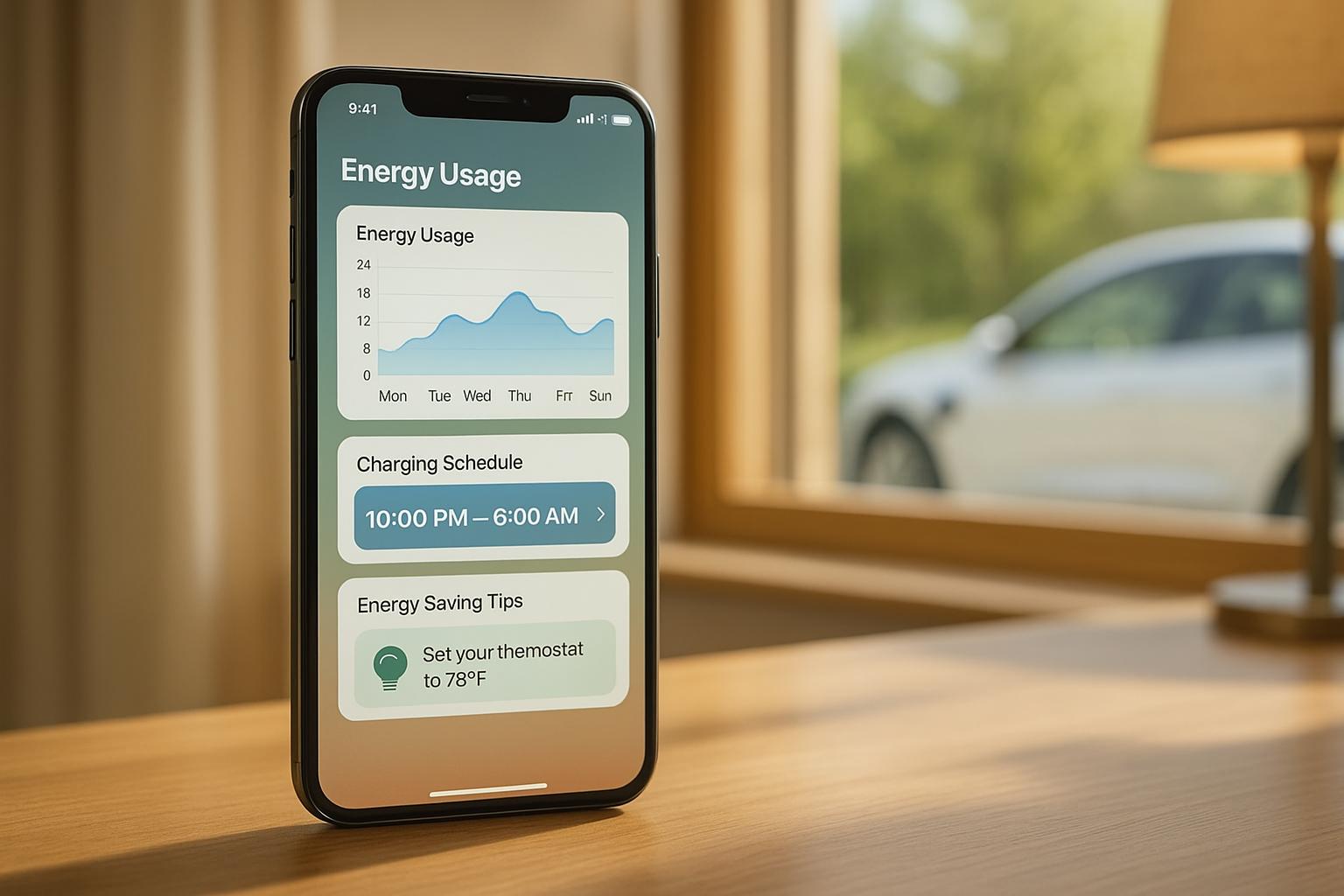
Want to save on EV charging and manage energy smarter? Mobile apps are transforming how we control energy usage and charging schedules, offering savings of up to 30% on costs. With EV adoption predicted to hit 50% of new car sales by the end of the 2020s, these tools are becoming must-haves for drivers and businesses alike.
Here’s what they can do for you:
- Smart Charging Schedules: Align charging with off-peak hours to cut electricity bills.
- Real-Time Energy Tracking: Spot inefficiencies and reduce waste instantly.
- Billing Insights: Understand energy costs with automated tools and detailed analytics.
- AI & IoT Integration: Use predictive tools to optimize charging and reduce grid strain.
For businesses, these apps can slash energy expenses – like office buildings spending $30,000 annually on energy – and improve operational efficiency. From AI-powered load management to intuitive interfaces, these tools simplify energy monitoring for fleets, public stations, and homes.
Quick Fact: A smart thermostat alone can reduce heating and cooling costs by 10–12%, while smart lighting saves up to 27% on electricity.
Mobile energy solutions are reshaping the way we charge and consume energy, making it easier, cheaper, and more efficient for everyone.
What is Smart Charging? Save Money & Optimise Your EV Charging
Core Functions for Energy Management Apps
Energy management apps provide precise control over EV charging, helping users achieve up to 30% cost savings.
Setting Up Charging Times
Smart scheduling ensures efficient charging by aligning sessions with daily routines and electricity rates. Users can choose one-time or recurring options to fit their needs.
For example, Dick Lovett Porsche improved their charging process by using Wevo Energy to schedule charging sessions during off-peak hours, cutting down costs significantly.
Here are some key scheduling features and their benefits:
| Feature | Benefit | Impact |
|---|---|---|
| Time-of-Use Programming | Schedule charging during off-peak hours | Save up to 30% on charging costs |
| Remote Adjustments | Change charging times instantly | Greater flexibility for users |
| Priority Settings | Prioritize critical vehicles for charging | Better fleet management |
These features not only streamline scheduling but also pave the way for effective real-time energy monitoring.
Live Energy Usage Tracking
Real-time tracking helps users identify inefficiencies and anomalies in energy consumption.
"The app provides users with real-time feedback on their energy usage, as well as tips on how to reduce their energy consumption – all in the palm of your hand." – GridPoint
One manufacturer using FAT FINGER‘s audit app reported a 20% reduction in energy consumption by quickly spotting and addressing wasteful practices.
When paired with live monitoring, detailed billing insights add another layer of control over energy expenses.
Price Tracking and Billing
Clear billing management is essential for understanding energy costs. According to ENERGY STAR, 30% of utility use in public buildings is wasted every cycle.
Advanced billing systems offer features like:
- Automated utility bill entry for smoother processing
- Interval meter analytics to break down consumption patterns
- Tariff analysis tools to optimize contracts
DVM Industries is a great example of how smart billing can make a difference. By using Wevo Energy’s software across thousands of NYC charging stations, they gained better control over energy costs and improved billing efficiency.
Thanks to machine learning, organizations can now save up to 90% of the time typically spent analyzing energy data. This makes it easier to uncover cost-saving opportunities and fine-tune charging schedules.
Tech Solutions for Better Energy Management
AI and IoT are reshaping how EV charging operates, improving efficiency, easing grid demand, and lowering costs.
AI for Smart Charging
AI brings a smarter approach to EV charging by analyzing user behavior and grid conditions to optimize operations.
"AI alleviates station congestion by balancing load demand and reducing grid strain, enabling a more reliable charging experience to help CPOs drive greater EV adoption and maximize profits." – Driivz
Here’s a snapshot of AI’s impact on charging efficiency:
| Feature | Benefit | Performance Metric |
|---|---|---|
| Predictive Maintenance | Remote Issue Resolution | 80% of problems fixed remotely |
| Dynamic Load Management | Grid Strain Reduction | 2-4 kW load shift per vehicle |
| Smart Scheduling | Cost Optimization | 43% energy savings |
For instance, Shell Recharge employs smart grid management to balance power loads while integrating renewable energy sources. On top of this, presenting energy data visually makes managing energy consumption even more intuitive.
Energy Data Graphics
While AI fine-tunes charging routines, clear visualization of energy data helps users understand and adjust their charging habits effectively.
To make energy trends easy to interpret, there are some key design principles to follow:
- High-contrast displays: Ensure readability in various lighting conditions.
- Limited color palette: Stick to 3-4 colors to highlight trends clearly.
- Interactive elements: Include features like tooltips or tap-responsive interfaces for deeper insights.
These design strategies make energy data more accessible, empowering users to make smarter decisions.
Connected Device Systems
IoT integration takes energy management to the next level, enabling a seamless and holistic approach. The market for IoT-enabled EV charging is expected to grow from $15.91 billion in 2024 to $120 billion by 2032.
For example, Shell Recharge’s IoT network has already cut over 2,000 tons of carbon emissions annually through its global network of smart chargers. Key communication protocols play a vital role in this ecosystem:
| Protocol | Primary Function |
|---|---|
| OCPP | Charging station management |
| ISO 15118 | Vehicle-to-grid communication |
| MQTT | Fast data transfer |
A real-world example of IoT’s potential is the collaboration between Fortune Electric and ASUS IoT in Taiwan. They’ve implemented AI-powered license plate recognition and adaptive load management, showcasing how connected systems can enhance charging efficiency.
Design Standards for Energy Apps
Beyond core functionality, well-thought-out design standards ensure energy management apps are both effective and user-friendly.
Easy-to-Use Scheduling Tools
An intuitive interface with touch-friendly controls and simple navigation enhances the user experience. By focusing on frequently used functions and maintaining a clean layout, these tools simplify scheduling tasks.
Here are some key design elements:
| Design Element | Purpose | User Benefit |
|---|---|---|
| Dynamic Widgets | Quick access to common tasks | Saves time navigating menus |
| Touch-Friendly Controls | Easy interaction on mobile devices | Reduces input errors |
| Logical Organization | Clear task hierarchy | Speeds up scheduling |
Clear Energy Data Display
Displaying energy data in a clear and accessible way is just as important as intuitive scheduling. Studies reveal that traditional charts are 22.74% easier to understand, 13.44% more effective, and 10.54% more visually appealing.
To maximize clarity:
- Use traditional charts with dark backgrounds for larger screens and light themes for mobile devices to improve readability.
- Opt for color schemes that ensure visibility across different devices.
A standout example is the CoolClimate Project, which uses a gradient from green to red to represent carbon emissions across 30,000 ZIP codes in the U.S. This approach makes complex data visually engaging and easy to interpret.
Custom Settings and Access
Personalization plays a key role in meeting diverse user needs. Energy apps should strike a balance between flexibility and a consistent user experience. Key features include:
- Support for multiple languages and currencies for global users.
- Adjustable color schemes and branding options to align with user preferences.
- Role-based access controls to suit different user types.
In April 2019, McKinsey reported that energy companies use detailed location and housing data to identify customers with higher-than-average energy consumption, offering tailored solutions like photovoltaic installations. Additionally, energy management systems often include dashboards and customizable reports, allowing users to efficiently monitor their consumption data.
sbb-itb-7af2948
Success Stories and Examples
Mobile interfaces are reshaping how energy is managed across various sectors, delivering cost savings, operational efficiency, and environmental benefits.
EV Network Improvements
Fleet operators and charging networks are leveraging mobile technology to optimize energy use and cut costs. For example, Revel, an EV fleet operator, utilized Ampcontrol‘s software for its Tesla fleet, slashing monthly demand charges by 45% while keeping all vehicles fully charged. Similarly, Takealot and Aeversa reported a 65% reduction in energy expenses through smart charging management systems.
"AMPECO’s platform not only meets our current needs for scalability but also offers the flexibility crucial for our future growth. It gives us full control over our charging network and the ability to create tailored solutions that deliver valuable services to our customers."
- Arjan van der Eijk, COO, E.ON Drive Infrastructure
Mobile solutions also play a significant role in reducing environmental impact. For instance, ev.energy‘s app has helped cut 160 tonnes of CO₂ emissions while delivering 10,000 MWh of energy and saving approximately $280,000:
| Metric | Achievement |
|---|---|
| CO₂ Reduction | 160 tonnes |
| Energy Delivered | 10,000 MWh |
| Cost Savings | $280,000 |
WattEV‘s initiative at North America’s largest electric truck charging site highlights how mobile interfaces can manage complex infrastructure without compromising availability. Their solution reduced peak power demand while ensuring drivers had a seamless experience.
These examples underline how mobile technology is transforming fleet and network energy management. But the benefits extend beyond commercial applications, offering significant savings and efficiency in residential settings too.
Home Energy Control
Mobile apps are proving to be game-changers in household energy management. According to the EPA, smart thermostats that meet energy efficiency standards can lower energy bills by 8%, while smart lighting systems can reduce energy consumption by 7–27%.
At New Times Square Condominium, 375 units equipped with 21 EV chargers achieved $24,000 in savings using SWTCH Control™, a smart load management solution.
The integration of smart appliances via mobile apps has shown measurable results:
| Technology | Energy Savings |
|---|---|
| Smart HVAC | Up to 10% |
| Smart Appliances | 2–9% |
| Smart Thermostats | 10–12% heating, 15% cooling |
| Utility Bills | 5–22% reduction |
Nest’s smart thermostat system is another success story, with early adopters reporting annual savings of $131 to $145 per household. These examples highlight how mobile interfaces are bridging advanced energy technologies with everyday life, making energy management accessible and effective for everyone.
Conclusion: Partner with Sidekick Interactive

Managing energy efficiently requires secure, easy-to-use mobile solutions, especially for EV charging and monitoring. Sidekick Interactive specializes in creating custom mobile apps that blend cutting-edge technology with intuitive design, all while adhering to strict data protection regulations.
This blend of expertise is vital as digital energy systems grow more interconnected. With this evolution comes heightened cybersecurity risks. For example, the average cost of a data breach hit $4.45 million in 2023.
The importance of secure energy systems is underscored by gridX Security Team Lead Alei Salem, who stated:
"Without energy, we’re without power, and then we’re effectively thrown back into the caveman era."
The stakes are high. In 2022 alone, around 1,700 incidents – ranging from attacks to vandalism – targeted energy facilities. Sidekick Interactive tackles these challenges head-on by integrating proactive security measures and adhering to industry best practices for data protection. These efforts align seamlessly with their broader strategy for comprehensive energy management.
Here’s how Sidekick Interactive’s expertise stands out:
| Capability | Benefit |
|---|---|
| Custom Native Development | Improved performance and stronger security |
| Advanced Data Protection | Compliance with GDPR and CCPA requirements |
| User-Centered Design | Better user adoption and overall satisfaction |
| Technical Integration | Smooth compatibility with existing systems |
Collaborate with Sidekick Interactive to create secure, innovative mobile solutions that push energy management into the future.
Conclusion: Partner with Sidekick Interactive
Managing energy efficiently through mobile interfaces demands solutions that are both advanced and easy to use. By 2030, integrating IoT into energy systems could slash electricity consumption by over 1.6 petawatt-hours. On top of that, 39% of energy and utility companies are already investing in generative AI teams to drive innovation.
The numbers back up these forward-thinking strategies. For example, the University of Zaragoza cut energy costs by 70% using IoT-based systems to optimize campus energy usage. In Manhattan, the 45 Broadway building reduced HVAC consumption by 15.8%, translating to $42,000 in savings over just eleven months, thanks to intelligent energy monitoring.
Katherine Lazarevich, co-founder and senior tech expert at Digiteum, emphasizes the importance of custom solutions:
"If software is core to your business and impacts your ability to compete, invest in custom-developed solutions."
As discussed earlier, tackling cybersecurity risks and ensuring seamless system compatibility are non-negotiable. Sidekick Interactive addresses these priorities through a tailored approach, offering custom native development that focuses on secure and efficient integration. Here’s how they do it:
| Feature | Implementation |
|---|---|
| Real-time Monitoring | Advanced visualization tools provide real-time insights into energy consumption. |
| AI Integration | Predictive analytics help create optimized charging schedules. |
| Security Protocols | Data encryption and multi-factor authentication ensure robust protection. |
| System Compatibility | Designed to integrate effortlessly with existing building management systems. |
With the global IoT energy market projected to hit $35 billion by 2025, partnering with Sidekick Interactive can give your business a competitive advantage. Their expertise in data security and AI-driven solutions ensures scalable, secure applications that meet today’s complex energy management needs.
FAQs
How can smart charging schedules help EV owners save on electricity costs?
Smart charging schedules give electric vehicle (EV) owners a way to cut down on electricity costs by charging their cars during off-peak hours when electricity rates are lower. This technique, called load shifting, not only saves money but also helps make energy use more efficient.
With many smart charging systems, the process gets even easier. These systems can automatically adjust charging times based on real-time electricity rates, ensuring owners always charge at the lowest possible cost. Some systems also connect with renewable energy sources, like solar panels, allowing EV owners to tap into free, sustainable energy whenever it’s available. It’s a convenient and cost-effective way for EV owners to save money while being mindful of their energy use.
How do AI and IoT improve energy management and help reduce strain on the power grid?
AI and IoT are transforming energy management by combining real-time monitoring with predictive analytics. AI systems analyze patterns to forecast energy demand and allocate resources more effectively, helping to avoid issues like overloads and blackouts.
Meanwhile, IoT devices gather data from sources such as smart meters and connected appliances, offering valuable insights for informed decision-making and adaptable energy strategies. Working together, these technologies build a smarter, more efficient energy system that eases grid pressure and boosts reliability.
How can mobile apps help businesses monitor and manage energy use more effectively?
Mobile apps give businesses a powerful way to monitor energy use in real-time, helping them spot inefficiencies and adjust consumption. By analyzing energy patterns and shifting usage to off-peak hours, companies can cut expenses and run operations more smoothly.
These tools also make energy data and billing more transparent, which can strengthen customer trust and loyalty. On top of that, they align with sustainability efforts, allowing businesses to track and reduce their environmental footprint. With these apps, managing energy becomes simpler, while staying competitive in the market gets easier.

